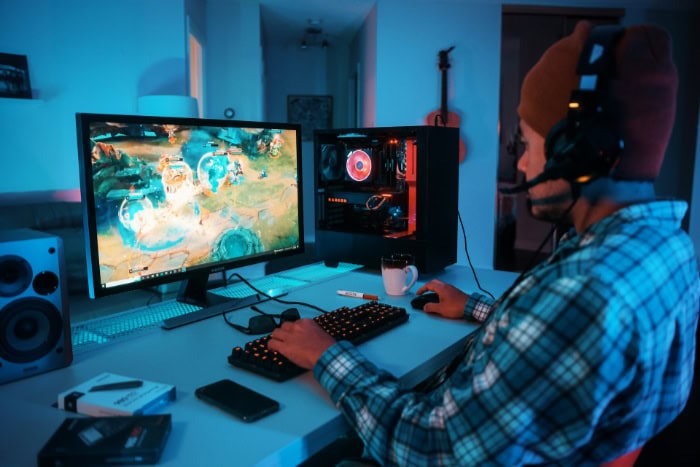What Is Stream Sniping? Streamers' Worst Nightmare

Stream sniping has become a notorious phenomenon in the world of online gaming and streaming. As more gamers turn to platforms like Twitch and YouTube to share their gameplay with audiences worldwide, a new form of unsportsmanlike conduct has emerged.
Stream sniping occurs when viewers exploit the live nature of streams to gain an unfair advantage or disrupt the streamer's experience. This practice not only undermines the integrity of the gaming community but also poses significant challenges for content creators and developers alike.
Definition and Mechanics of Stream Sniping
Stream sniping is a form of cheating in online gaming where a viewer uses information from a live stream to gain an unfair advantage over the streamer or disrupt their gameplay experience. This practice has become increasingly prevalent with the rise of streaming platforms like Twitch, YouTube Gaming, and Facebook Gaming.
Stream snipers exploit the fact that streamers often share their live gameplay footage with little to no delay, allowing viewers to see the streamer's location, strategy, and other sensitive information in real-time.
How Stream Sniping is Executed
Stream sniping occurs when a viewer tunes into a live stream and attempts to join the same game server or match as the streamer. Once in the same game, the stream sniper can use the information gleaned from the live stream to their advantage.
This may involve:
- Locating and eliminating the streamer's character
- Stealing valuable resources or loot from the streamer
- Disrupting the streamer's gameplay by harassing, trolling, or sabotaging their progress
- Scouting the streamer's location and strategy to gain a competitive edge
Stream snipers may also engage in stream camping, where they repeatedly target the same streamer across multiple games or sessions.
Common Platforms and Games Affected
Stream sniping can occur on any platform that supports live streaming, but it is most prevalent on popular gaming platforms like Twitch, YouTube Gaming, and Facebook Gaming. The games most commonly targeted by stream snipers are typically multiplayer titles where players can easily join the same game as the streamer.
Some examples include:
- Battle royale games: Fortnite, PlayerUnknown's Battlegrounds (PUBG), Apex Legends, Call of Duty: Warzone
- Competitive multiplayer games: Counter-Strike: Global Offensive (CS:GO), Overwatch, Valorant, Dota 2, League of Legends
- Survival games: Rust, DayZ, Escape from Tarkov
- Open-world multiplayer games: Grand Theft Auto Online, Red Dead Online, Minecraft
While stream sniping can occur in any multiplayer game, it is particularly problematic in competitive titles where the stakes are higher, and the impact on the streamer's experience is more significant.
Impact on Streamers

Stream sniping can have a profound impact on content creators who rely on streaming platforms to build their audience, engage with fans, and generate income. The effects of stream sniping extend beyond the game itself, often leading to a range of negative consequences for streamers.
Disruption of Gameplay and Content Quality
One of the most immediate impacts of stream sniping is the disruption of the streamer's gameplay experience. When stream snipers target a content creator, they can derail the streamer's progress, ruin their in-game strategies, and ultimately diminish the quality of the content being produced.
This can be particularly frustrating for streamers who are attempting to create engaging, entertaining, or educational content for their audience.
Stream sniping can also lead to a less enjoyable viewing experience for the audience. Viewers may become frustrated or disinterested when the streamer's gameplay is constantly interrupted or sabotaged by stream snipers.
This can result in a loss of viewership and a decline in the streamer's overall popularity and growth potential.
Mental Health and Privacy Concerns
Beyond the disruption of gameplay, stream sniping can also take a toll on a streamer's mental health and sense of privacy. Content creators often form close connections with their audience and may share personal stories or experiences during their streams.
When stream snipers repeatedly target a streamer, it can feel like a personal attack or invasion of privacy.
The constant harassment and trolling that often accompany stream sniping can lead to increased stress, anxiety, and burnout among content creators. Some streamers may even choose to take breaks from streaming or abandon the platform altogether due to the emotional strain caused by stream sniping.
Competitive Disadvantages in Tournaments
For professional gamers and streamers who participate in competitive tournaments, stream sniping can have severe consequences. Many tournaments are now broadcast live on streaming platforms, allowing viewers to see the strategies, positions, and movements of players in real-time.
Stream snipers can use this information to gain an unfair advantage over the competing streamers, potentially influencing the outcome of matches and tournaments. This not only undermines the integrity of the competition but can also lead to significant financial losses for the affected streamers, as tournament prizes and sponsorship opportunities may be at stake.
The competitive disadvantage caused by stream sniping can also discourage streamers from participating in tournaments or lead to a decline in the overall quality and fairness of competitive gaming events.
Prevention and Mitigation Strategies

As stream sniping continues to pose challenges for content creators and the gaming community at large, various strategies have been developed to prevent and mitigate its impact. These strategies involve efforts from both streamers themselves and the platforms and game developers that support them.
Streamer-Implemented Measures
Streamers can take several proactive steps to reduce the likelihood of being targeted by stream snipers:
Stream Delays: One of the most effective ways to combat stream sniping is to introduce a delay between the streamer's live gameplay and the broadcast seen by viewers. By adding a delay of several seconds or minutes, streamers can prevent stream snipers from using real-time information to their advantage.
However, this approach can also reduce viewer engagement and interaction, as the streamer's responses to chat messages and donations may appear less timely.
Hiding Sensitive Information: Streamers can also protect themselves by hiding sensitive information from their live broadcasts. This may involve covering or obscuring portions of the screen that display the streamer's location, minimap, or other strategic elements.
Some streamers also choose to hide their in-game name or use alternate accounts to make it more difficult for stream snipers to identify and target them.
Using Streamer Modes: Many games now offer built-in “streamer modes” that help content creators protect themselves from stream sniping. These modes may include features like hidden matchmaking, which prevents stream snipers from easily joining the same game as the streamer, or the ability to hide the streamer's in-game name or identifier.
Streamers can take advantage of these tools to reduce their vulnerability to stream sniping.
Platform and Game Developer Efforts
In addition to streamer-implemented measures, streaming platforms and game developers play a crucial role in combating stream sniping:
In-Game Features to Combat Stream Sniping: Game developers can incorporate various features and tools to help streamers protect themselves from stream sniping. These may include anonymous or hidden matchmaking systems, the ability to hide player names or identifiers, or built-in stream delay options.
By prioritizing streamer safety and implementing robust anti-stream sniping measures, game developers can foster a more secure and enjoyable environment for content creators.
Reporting Systems and Penalties: Streaming platforms and game developers can also establish clear reporting systems and penalties for stream sniping. This may involve providing streamers with tools to easily report suspected stream snipers and implementing consequences for those found to be engaging in this behavior.
Penalties may range from temporary bans to permanent account suspensions, depending on the severity and frequency of the offense. By taking a strong stance against stream sniping and enforcing consequences, platforms and developers can help deter this behavior and create a safer streaming ecosystem.
Ethical and Community Considerations

Stream sniping raises important ethical questions and sparks discussions within the gaming community about fair play, sportsmanship, and the responsibilities of viewers and streamers alike. As the streaming ecosystem continues to evolve, it is crucial to consider the broader implications of stream sniping and how it shapes the culture and norms of online gaming.
Fair Play and Sportsmanship in Gaming
At its core, stream sniping violates the principles of fair play and sportsmanship that are essential to the integrity and enjoyment of gaming. When players engage in stream sniping, they gain an unfair advantage over their opponents, undermining the spirit of competition and the sense of accomplishment that comes from genuine skill and strategy.
The prevalence of stream sniping can erode trust within the gaming community, as players may become suspicious of one another and question the legitimacy of victories and losses. This can lead to a toxic and hostile environment that detracts from the overall gaming experience.
To promote fair play and sportsmanship, it is essential for the gaming community to actively discourage stream sniping and emphasize the importance of respectful and honest competition. This may involve fostering a culture of integrity, educating players about the harms of stream sniping, and celebrating those who uphold the values of fair play.
Community Response to Stream Sniping
The gaming community has responded to stream sniping in various ways, reflecting a range of attitudes and opinions on the issue. Some players and viewers condemn stream sniping as a form of cheating and advocate for strict penalties and consequences for those who engage in this behavior.
They argue that stream sniping undermines the integrity of the gaming experience and puts content creators at an unfair disadvantage.
Others view stream sniping as an inevitable consequence of the open nature of streaming and believe that the responsibility lies with streamers to protect themselves. They may argue that streamers who choose to broadcast their gameplay in real-time should accept the risks and take appropriate measures to mitigate the impact of stream sniping.
The debate surrounding stream sniping highlights the complex dynamics between streamers, viewers, and the broader gaming community. It raises questions about the boundaries of acceptable behavior, the responsibilities of content creators, and the role of platforms and game developers in creating a safe and fair environment for all players.
Balancing Interaction with Protection
One of the challenges in addressing stream sniping is striking a balance between fostering interaction and engagement between streamers and their audience while also protecting content creators from malicious behavior. Streaming platforms have become popular precisely because they allow for real-time communication and a sense of connection between streamers and viewers.
However, this interaction can also make streamers more vulnerable to stream sniping and other forms of harassment. Implementing measures like stream delays or hiding sensitive information can help protect streamers, but they may also reduce the immediacy and intimacy of the streaming experience.
Finding the right balance requires ongoing dialogue and collaboration between streamers, viewers, platforms, and game developers. It may involve developing new tools and features that allow for interaction while minimizing the risk of stream sniping, as well as establishing clear guidelines and expectations for viewer behavior.
Conclusion
Stream sniping has emerged as a significant challenge in the world of online gaming and streaming, with far-reaching consequences for content creators, viewers, and the gaming community as a whole. From disrupting gameplay and compromising the mental well-being of streamers to undermining the integrity of competitive tournaments, stream sniping poses a complex set of issues that require a multi-faceted approach to address effectively.
Combating stream sniping demands a concerted effort from all stakeholders in the gaming ecosystem. Streamers must take proactive measures to protect themselves, such as implementing stream delays, hiding sensitive information, and utilizing streamer modes when available.
Streaming platforms and game developers play a crucial role in providing robust tools, reporting systems, and penalties to deter and punish stream sniping behavior.
However, the battle against stream sniping extends beyond technical solutions and punitive measures. It requires a fundamental shift in the gaming community's culture and values, emphasizing fair play, sportsmanship, and respect for content creators.
As the streaming landscape continues to evolve, it is essential to maintain an ongoing dialogue about the challenges posed by stream sniping and adapt strategies accordingly. Through collaboration, education, and a commitment to upholding the principles of fair play, the gaming community can strive to create a streaming ecosystem that is both vibrant and secure, allowing content creators to thrive and viewers to enjoy the excitement of live gameplay without the threat of malicious interference.


